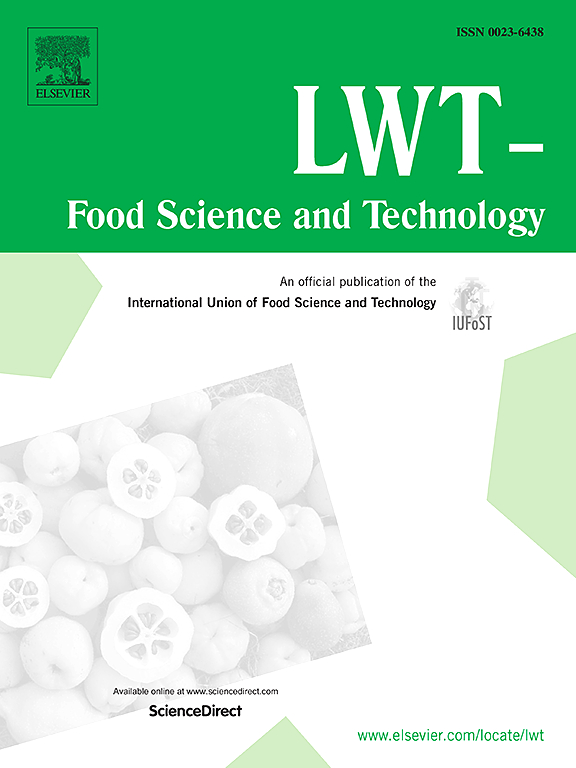High-amylose starch nanocrystals produced via sulfuric acid hydrolysis and ultrasonication: Impact on resistant starch content and emulsification capacity
IF 6
1区 农林科学
Q1 FOOD SCIENCE & TECHNOLOGY
引用次数: 0
Abstract
Combined ultrasound–sulfuric acid hydrolysis is an efficient approach for preparing starch nanocrystals, but its application to high-amylose corn starch (HAS) remains underexplored, particularly in terms of its effects on emulsifying capacity and resistant starch (RS) content. In this study, HAS was treated with combined ultrasound–sulfuric acid hydrolysis for 1, 3, 5, and 7 days. The resulting nanocrystals (HNC) were characterized for particle size, zeta potential, crystalline structure, ATR-FTIR spectra, amylopectin chain-length distribution, RS content, and morphology. Their emulsion-stabilizing performance was evaluated under various environmental conditions, including pH, NaCl concentration, storage, and centrifugation. As the treatment time increased (from day 1 to day 5), particle size decreased while relative crystallinity (RC) increased. HNC-5d exhibited the smallest particle size (292.3 nm), highest RC (72.3 %), and maximum RS content (68.8 %). However, prolonged treatment (beyond 5 days) resulted in structural degradation, leading to increased particle size and reduced RC and RS content. Emulsions stabilized by HNC-5d showed superior emulsifying capacity and environmental stability. These findings elucidate how treatment duration affects HNC structure and support its potential as a low-sugar Pickering emulsifier. Future research may optimize processing and validate the delivery performance and digestive fate of HNC in complex food systems.
硫酸水解和超声法制备高直链淀粉纳米晶:对抗性淀粉含量和乳化能力的影响
超声-硫酸联合水解是制备淀粉纳米晶的有效方法,但其在高直链淀粉(HAS)中的应用仍有待探索,特别是其对乳化能力和抗性淀粉(RS)含量的影响。在本研究中,采用超声-硫酸联合水解法对HAS进行了1、3、5和7天的处理。通过粒径、zeta电位、晶体结构、ATR-FTIR光谱、支链淀粉链长分布、RS含量和形貌对所得纳米晶体(HNC)进行表征。在不同的环境条件下,包括pH、NaCl浓度、储存和离心,评价了它们的乳液稳定性能。随着处理时间的增加(从第1天到第5天),颗粒尺寸减小,相对结晶度(RC)增加。HNC-5d的粒径最小(292.3 nm), RC最高(72.3%),RS含量最高(68.8%)。然而,长时间处理(超过5天)会导致结构降解,导致颗粒尺寸增大,RC和RS含量降低。经HNC-5d稳定的乳剂具有良好的乳化能力和环境稳定性。这些发现阐明了处理时间如何影响HNC结构,并支持其作为低糖皮克林乳化剂的潜力。未来的研究可能会优化加工和验证HNC在复杂食物系统中的传递性能和消化命运。
本文章由计算机程序翻译,如有差异,请以英文原文为准。
求助全文
约1分钟内获得全文
求助全文
来源期刊

LWT - Food Science and Technology
工程技术-食品科技
CiteScore
11.80
自引率
6.70%
发文量
1724
审稿时长
65 days
期刊介绍:
LWT - Food Science and Technology is an international journal that publishes innovative papers in the fields of food chemistry, biochemistry, microbiology, technology and nutrition. The work described should be innovative either in the approach or in the methods used. The significance of the results either for the science community or for the food industry must also be specified. Contributions written in English are welcomed in the form of review articles, short reviews, research papers, and research notes. Papers featuring animal trials and cell cultures are outside the scope of the journal and will not be considered for publication.
 求助内容:
求助内容: 应助结果提醒方式:
应助结果提醒方式:


